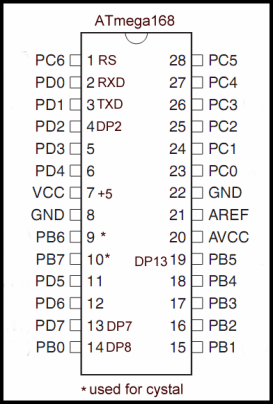

- Arduino uno port map how to#
- Arduino uno port map serial#
- Arduino uno port map update#
- Arduino uno port map full#
Well, to begin there is a dedicated register for each PORT that defines if each pin is a input or an output, that register is the DDRx, where x is the letter from the PORT that we want to configure, in the case of the Arduino there is DDRB, DDRC and DDRD.

So, how can we interact with our digital pins? In this image you can see all the alternative functions that each pin can have, the chip in question is the Atmega328p.Īnd here is the mapping between arduino port names and their real name:
Arduino uno port map full#
Our micro-controller, the Atmega328p as registers, those registers are associated with the input/output ports, each port as a specific name and the associated registers, in fact our atmega as port B,C and D, and each port as a different number of pins(this is a restriction of the 28 pins PDIP package and not from the micro-controller, because an 40 pins PDIP for example as 4 ports with the full 8 bits each one), the only port that as the full 8 input/output pins is PORTD.Īs you may already know, each pin can have multiple functions, like pwm generation, or ADC capabilities, the pins 7 and 7 from PORTB are also the input pins for the crystal oscillator, and pin 6 from PORTC is the reset button.
Arduino uno port map how to#
The values entered should be largely the same though.Hello fellow readers, today I will write a bit about the digital pins and how to read and write digital values to then, its a simple subject but of a great importance, because almost everything that our micro-controller does is using its inputs and outputs to talk with leds, motor drivers, lcd’s, shift-register, to read data from digital sensors and a lot other things, so lets start reading about how to do it. Please note: The steps and locations of these configuration pages will vary depending on your specific router. If you followed my previous post you can find this information on line 23 of your code. The HTTP port that your Arduino uses to listen for requests.For reference, in the steps below, my Arduino’s IP address is 192.168.10.136.
Arduino uno port map serial#
If you followed my previous post this information was printed in the Serial Monitor after uploading your sketch. If you aren’t sure, you can consult this list of default usernames and passwords. Your router’s administrator username and password.For reference, in the steps below, my router’s IP address is 192.168.10.1. You can follow this guide to find that information. If those disadvantages are deal breakers, and your willing to do a little more work, you can skip ahead to the second post in this series.īefore we get started, you should have the following information ready: It’s also worth noting that some services won’t accept an IP as a valid URL.
Arduino uno port map update#
If you were to create an app to control your devices, or if you wanted to use a service like IFTTT, you would need to recompile and redeploy your app or update all of your integrations every time your external IP changed. IP addresses aren’t very easy to remember, and your external IP can change for various reasons such as rebooting your modem or upgrading your equipment. The final disadvantage is that you have to use an IP address to make requests. If you are working with a one or two devices this isn’t a big deal, but it doesn’t scale well.

Port forwarding can be perfectly safe if you follow the right practices, but implementing that security is outside the scope of this article and makes the setup more complex.Īnother disadvantage is that you’d have to open a port for each device on your network, and you would need to send a separate web request to each device. Hackers often scan for open ports, so they could potentially gain access to data on your local network. When you open a port on your router, that port is accessible to anyone. The biggest disadvantage to this method is security.


 0 kommentar(er)
0 kommentar(er)
